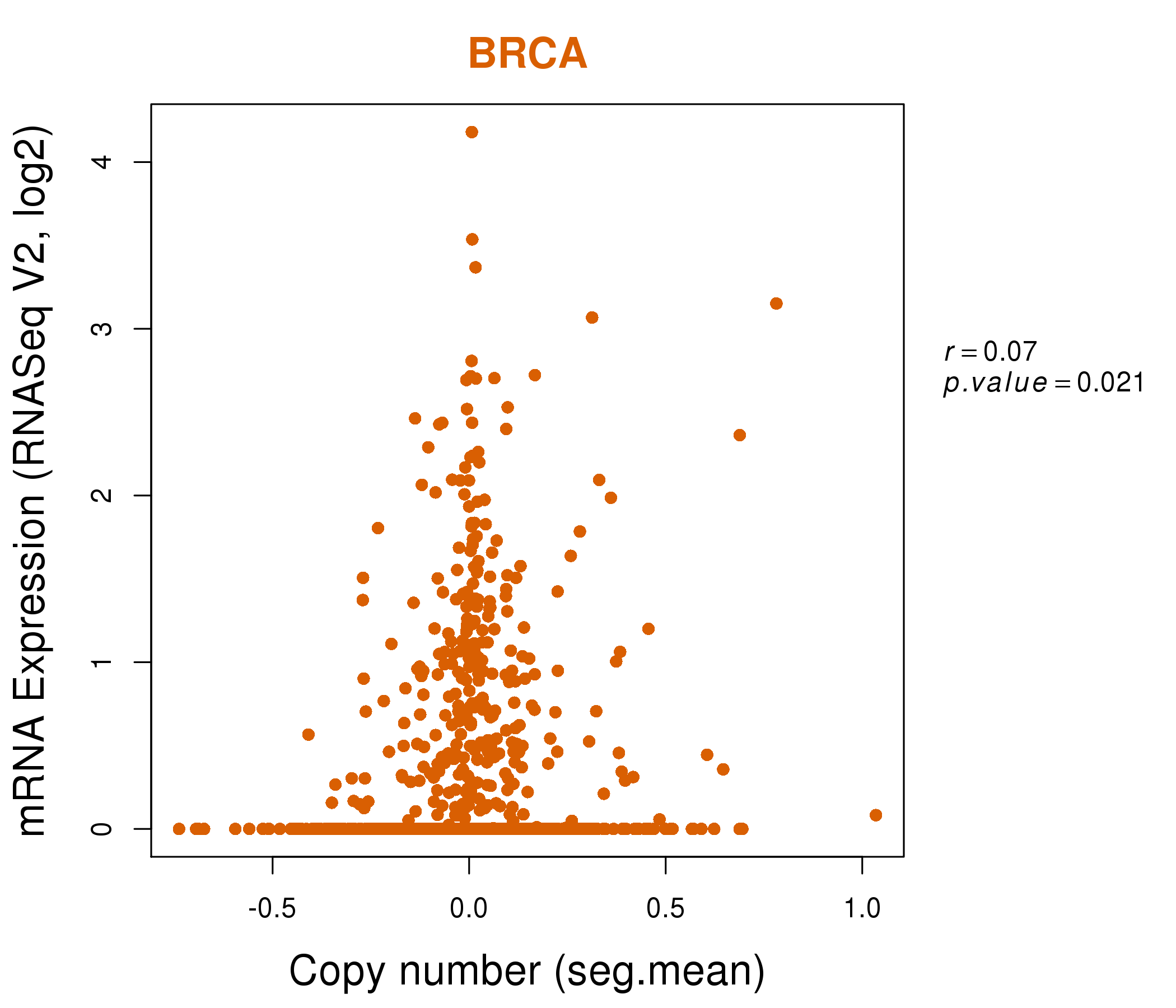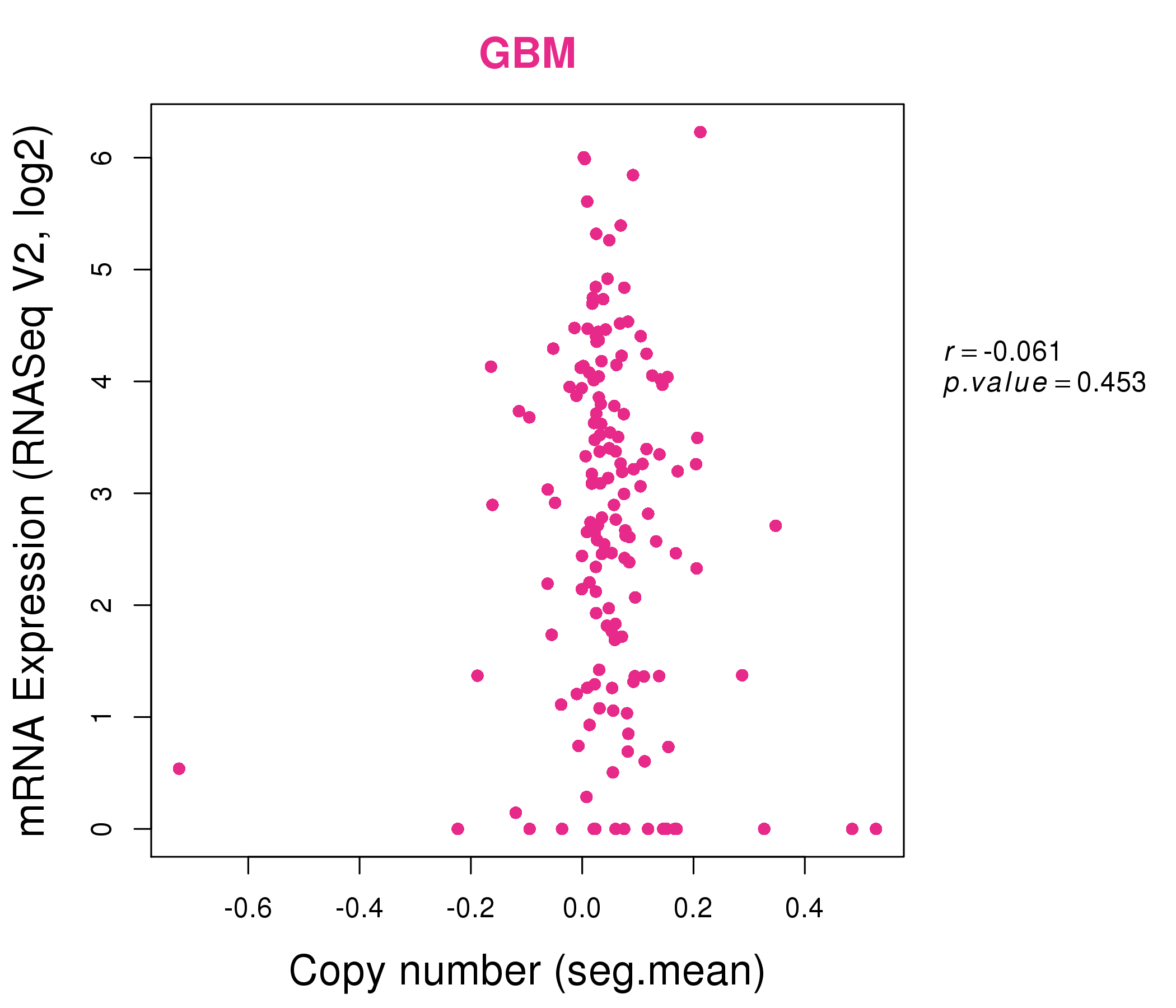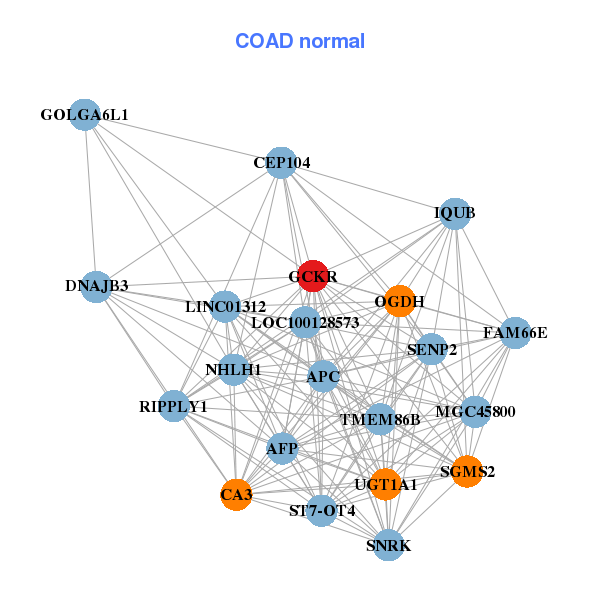|
||||||||||||||||||||||||||||||||||||||||||||||||||||||||||||||||||||||||||||||||||||||||||||||||||||||||||||||||||||||||||||||||||||||||||||||||||||||||||||||||||||||||||||||||||||||||||||||||||||||||||||||||||||||||||||||||||||||||||||||||||||||||||||||||||||||||||||||||||||||||||||||||||||||||||||||||||||||||||
| |
| Phenotypic Information (metabolism pathway, cancer, disease, phenome) |
| |
| |
| Gene-Gene Network Information: Co-Expression Network, Interacting Genes & KEGG |
| |
|
| Gene Summary for GCKR |
| Basic gene info. | Gene symbol | GCKR |
| Gene name | glucokinase (hexokinase 4) regulator | |
| Synonyms | FGQTL5|GKRP | |
| Cytomap | UCSC genome browser: 2p23 | |
| Genomic location | chr2 :27719705-27746550 | |
| Type of gene | protein-coding | |
| RefGenes | NM_001486.3, | |
| Ensembl id | ENSG00000084734 | |
| Description | glucokinase regulatory protein | |
| Modification date | 20141211 | |
| dbXrefs | MIM : 600842 | |
| HGNC : HGNC | ||
| Ensembl : ENSG00000084734 | ||
| HPRD : 02909 | ||
| Vega : OTTHUMG00000128426 | ||
| Protein | UniProt: Q14397 go to UniProt's Cross Reference DB Table | |
| Expression | CleanEX: HS_GCKR | |
| BioGPS: 2646 | ||
| Gene Expression Atlas: ENSG00000084734 | ||
| The Human Protein Atlas: ENSG00000084734 | ||
| Pathway | NCI Pathway Interaction Database: GCKR | |
| KEGG: GCKR | ||
| REACTOME: GCKR | ||
| ConsensusPathDB | ||
| Pathway Commons: GCKR | ||
| Metabolism | MetaCyc: GCKR | |
| HUMANCyc: GCKR | ||
| Regulation | Ensembl's Regulation: ENSG00000084734 | |
| miRBase: chr2 :27,719,705-27,746,550 | ||
| TargetScan: NM_001486 | ||
| cisRED: ENSG00000084734 | ||
| Context | iHOP: GCKR | |
| cancer metabolism search in PubMed: GCKR | ||
| UCL Cancer Institute: GCKR | ||
| Assigned class in ccmGDB | A - This gene has a literature evidence and it belongs to cancer gene. | |
| References showing role of GCKR in cancer cell metabolism | 1. Chin AI, Shu J, Shan Shi C, Yao Z, Kehrl JH, et al. (1999) TANK potentiates tumor necrosis factor receptor-associated factor-mediated c-Jun N-terminal kinase/stress-activated protein kinase activation through the germinal center kinase pathway. Mol Cell Biol 19: 6665-6672. pmid: 84649. go to article 2. Chambers JC, Zhang W, Sehmi J, Li X, Wass MN, et al. (2011) Genome-wide association study identifies loci influencing concentrations of liver enzymes in plasma. Nat Genet 43: 1131-1138. doi: 10.1038/ng.970. pmid: 3482372. go to article | |
| Top |
| Phenotypic Information for GCKR(metabolism pathway, cancer, disease, phenome) |
| Cancer | CGAP: GCKR |
| Familial Cancer Database: GCKR | |
| * This gene is included in those cancer gene databases. |
|
|
|
|
|
| . | ||||||||||||||||||||||||||||||||||||||||||||||||||||||||||||||||||||||||||||||||||||||||||||||||||||||||||||||||||||||||||||||||||||||||||||||||||||||||||||||||||||||||||||||||||||||||||||||||||||||||||||||||||||||||||||||||||||||||||||||||||||||||||||||||||||||||||||||||||||||||||||||||||||||||||||||||||||
Oncogene 1 | Significant driver gene in | |||||||||||||||||||||||||||||||||||||||||||||||||||||||||||||||||||||||||||||||||||||||||||||||||||||||||||||||||||||||||||||||||||||||||||||||||||||||||||||||||||||||||||||||||||||||||||||||||||||||||||||||||||||||||||||||||||||||||||||||||||||||||||||||||||||||||||||||||||||||||||||||||||||||||||||||||||||||||
| cf) number; DB name 1 Oncogene; http://nar.oxfordjournals.org/content/35/suppl_1/D721.long, 2 Tumor Suppressor gene; https://bioinfo.uth.edu/TSGene/, 3 Cancer Gene Census; http://www.nature.com/nrc/journal/v4/n3/abs/nrc1299.html, 4 CancerGenes; http://nar.oxfordjournals.org/content/35/suppl_1/D721.long, 5 Network of Cancer Gene; http://ncg.kcl.ac.uk/index.php, 1Therapeutic Vulnerabilities in Cancer; http://cbio.mskcc.org/cancergenomics/statius/ |
| REACTOME_METABOLISM_OF_CARBOHYDRATES | |
| OMIM | 600842; gene. 613463; phenotype. |
| Orphanet | |
| Disease | KEGG Disease: GCKR |
| MedGen: GCKR (Human Medical Genetics with Condition) | |
| ClinVar: GCKR | |
| Phenotype | MGI: GCKR (International Mouse Phenotyping Consortium) |
| PhenomicDB: GCKR | |
| Mutations for GCKR |
| * Under tables are showing count per each tissue to give us broad intuition about tissue specific mutation patterns.You can go to the detailed page for each mutation database's web site. |
| - Statistics for Tissue and Mutation type | Top |
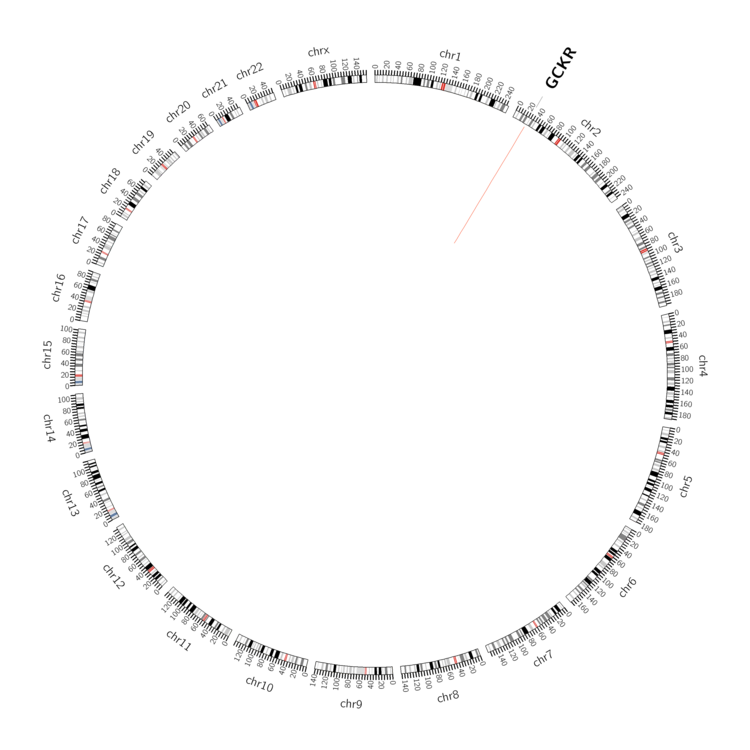 |
| - For Inter-chromosomal Variations |
| There's no inter-chromosomal structural variation. |
| - For Intra-chromosomal Variations |
| * Intra-chromosomal variantions includes 'intrachromosomal amplicon to amplicon', 'intrachromosomal amplicon to non-amplified dna', 'intrachromosomal deletion', 'intrachromosomal fold-back inversion', 'intrachromosomal inversion', 'intrachromosomal tandem duplication', 'Intrachromosomal unknown type', 'intrachromosomal with inverted orientation', 'intrachromosomal with non-inverted orientation'. |
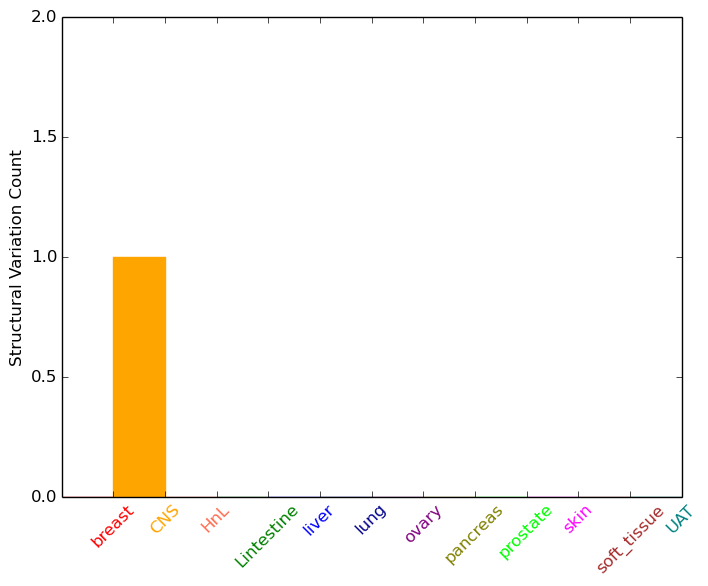 |
| Sample | Symbol_a | Chr_a | Start_a | End_a | Symbol_b | Chr_b | Start_b | End_b |
| central_nervous_system | GCKR | chr2 | 27744120 | 27744120 | GCKR | chr2 | 27744483 | 27744483 |
| cf) Tissue number; Tissue name (1;Breast, 2;Central_nervous_system, 3;Haematopoietic_and_lymphoid_tissue, 4;Large_intestine, 5;Liver, 6;Lung, 7;Ovary, 8;Pancreas, 9;Prostate, 10;Skin, 11;Soft_tissue, 12;Upper_aerodigestive_tract) |
| * From mRNA Sanger sequences, Chitars2.0 arranged chimeric transcripts. This table shows GCKR related fusion information. |
| ID | Head Gene | Tail Gene | Accession | Gene_a | qStart_a | qEnd_a | Chromosome_a | tStart_a | tEnd_a | Gene_a | qStart_a | qEnd_a | Chromosome_a | tStart_a | tEnd_a |
| Top |
| Mutation type/ Tissue ID | brca | cns | cerv | endome | haematopo | kidn | Lintest | liver | lung | ns | ovary | pancre | prost | skin | stoma | thyro | urina | |||
| Total # sample | 1 | |||||||||||||||||||
| GAIN (# sample) | 1 | |||||||||||||||||||
| LOSS (# sample) |
| cf) Tissue ID; Tissue type (1; Breast, 2; Central_nervous_system, 3; Cervix, 4; Endometrium, 5; Haematopoietic_and_lymphoid_tissue, 6; Kidney, 7; Large_intestine, 8; Liver, 9; Lung, 10; NS, 11; Ovary, 12; Pancreas, 13; Prostate, 14; Skin, 15; Stomach, 16; Thyroid, 17; Urinary_tract) |
| Top |
|
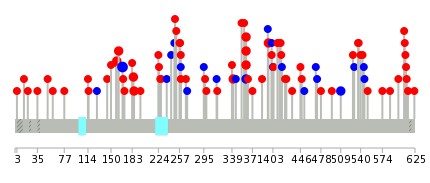 |
| Top |
| Stat. for Non-Synonymous SNVs (# total SNVs=57) | (# total SNVs=17) |
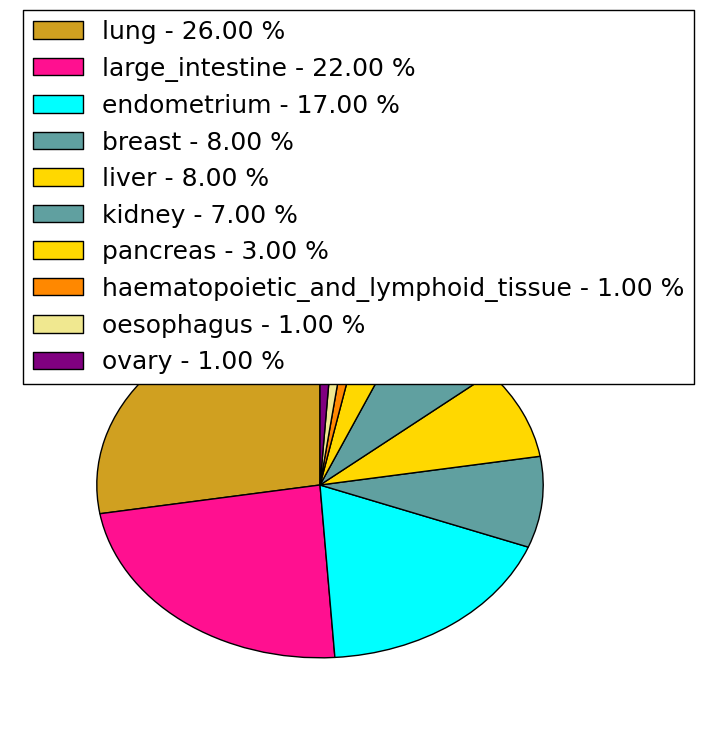 |  |
(# total SNVs=1) | (# total SNVs=0) |
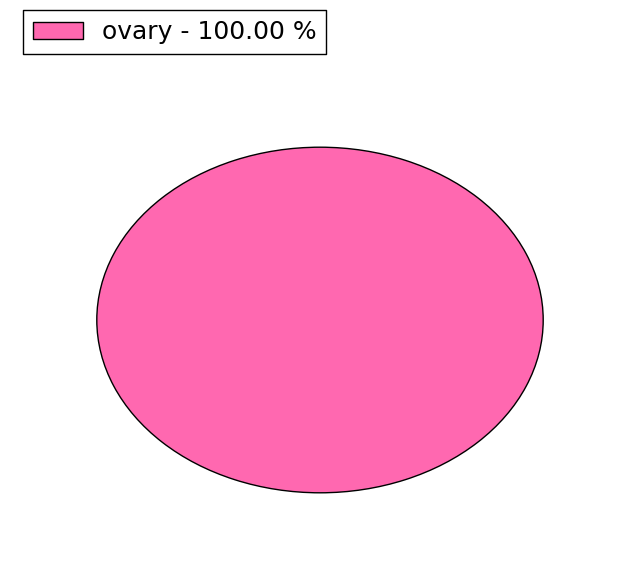 |
| Top |
| * When you move the cursor on each content, you can see more deailed mutation information on the Tooltip. Those are primary_site,primary_histology,mutation(aa),pubmedID. |
| GRCh37 position | Mutation(aa) | Unique sampleID count |
| chr2:27722272-27722272 | p.A168A | 4 |
| chr2:27730116-27730116 | p.R361S | 4 |
| chr2:27722064-27722064 | p.E162K | 2 |
| chr2:27729707-27729707 | p.I341V | 2 |
| chr2:27741759-27741759 | p.R509R | 2 |
| chr2:27730590-27730590 | p.I396V | 2 |
| chr2:27730117-27730117 | p.R361H | 2 |
| chr2:27724006-27724006 | p.P185L | 2 |
| chr2:27730118-27730118 | p.R361R | 2 |
| chr2:27724008-27724008 | p.F186I | 2 |
| Top |
|
 |
| Point Mutation/ Tissue ID | 1 | 2 | 3 | 4 | 5 | 6 | 7 | 8 | 9 | 10 | 11 | 12 | 13 | 14 | 15 | 16 | 17 | 18 | 19 | 20 |
| # sample | 1 | 2 | 12 | 1 | 2 | 7 | 5 | 3 | 13 | 4 | 9 | |||||||||
| # mutation | 2 | 2 | 10 | 1 | 2 | 7 | 5 | 3 | 21 | 4 | 11 | |||||||||
| nonsynonymous SNV | 2 | 2 | 7 | 1 | 2 | 5 | 4 | 1 | 13 | 2 | 10 | |||||||||
| synonymous SNV | 3 | 2 | 1 | 2 | 8 | 2 | 1 |
| cf) Tissue ID; Tissue type (1; BLCA[Bladder Urothelial Carcinoma], 2; BRCA[Breast invasive carcinoma], 3; CESC[Cervical squamous cell carcinoma and endocervical adenocarcinoma], 4; COAD[Colon adenocarcinoma], 5; GBM[Glioblastoma multiforme], 6; Glioma Low Grade, 7; HNSC[Head and Neck squamous cell carcinoma], 8; KICH[Kidney Chromophobe], 9; KIRC[Kidney renal clear cell carcinoma], 10; KIRP[Kidney renal papillary cell carcinoma], 11; LAML[Acute Myeloid Leukemia], 12; LUAD[Lung adenocarcinoma], 13; LUSC[Lung squamous cell carcinoma], 14; OV[Ovarian serous cystadenocarcinoma ], 15; PAAD[Pancreatic adenocarcinoma], 16; PRAD[Prostate adenocarcinoma], 17; SKCM[Skin Cutaneous Melanoma], 18:STAD[Stomach adenocarcinoma], 19:THCA[Thyroid carcinoma], 20:UCEC[Uterine Corpus Endometrial Carcinoma]) |
| Top |
| * We represented just top 10 SNVs. When you move the cursor on each content, you can see more deailed mutation information on the Tooltip. Those are primary_site, primary_histology, mutation(aa), pubmedID. |
| Genomic Position | Mutation(aa) | Unique sampleID count |
| chr2:27730116 | p.R361C | 4 |
| chr2:27730117 | p.P608L | 2 |
| chr2:27730118 | p.R509R | 2 |
| chr2:27746251 | p.R361H | 2 |
| chr2:27741759 | p.E536K | 2 |
| chr2:27745360 | p.R361R | 2 |
| chr2:27720202 | p.A114T | 1 |
| chr2:27722273 | p.V244V | 1 |
| chr2:27731106 | p.L364F | 1 |
| chr2:27728604 | p.P545P | 1 |
| * Copy number data were extracted from TCGA using R package TCGA-Assembler. The URLs of all public data files on TCGA DCC data server were gathered on Jan-05-2015. Function ProcessCNAData in TCGA-Assembler package was used to obtain gene-level copy number value which is calculated as the average copy number of the genomic region of a gene. |
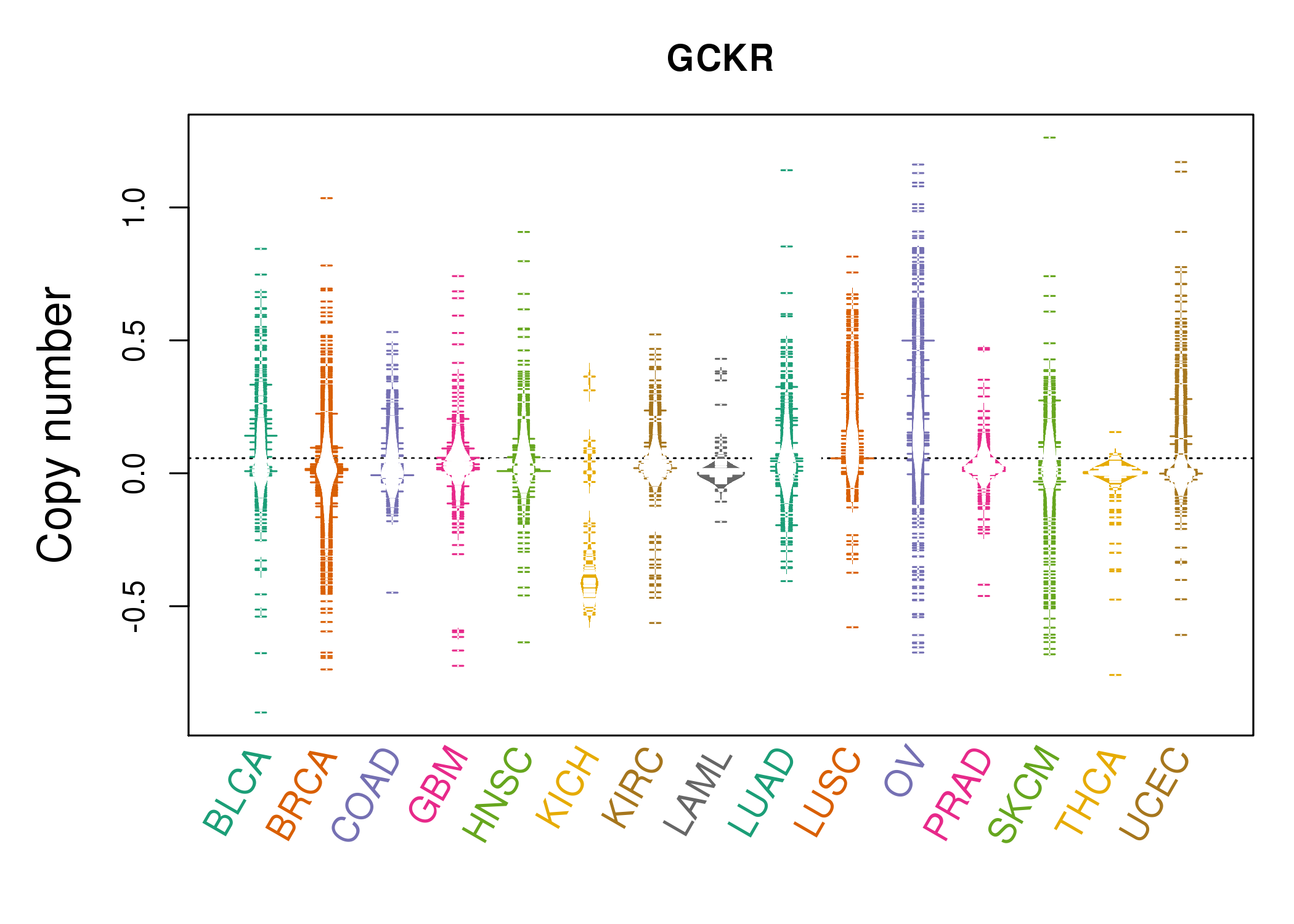 |
| cf) Tissue ID[Tissue type]: BLCA[Bladder Urothelial Carcinoma], BRCA[Breast invasive carcinoma], CESC[Cervical squamous cell carcinoma and endocervical adenocarcinoma], COAD[Colon adenocarcinoma], GBM[Glioblastoma multiforme], Glioma Low Grade, HNSC[Head and Neck squamous cell carcinoma], KICH[Kidney Chromophobe], KIRC[Kidney renal clear cell carcinoma], KIRP[Kidney renal papillary cell carcinoma], LAML[Acute Myeloid Leukemia], LUAD[Lung adenocarcinoma], LUSC[Lung squamous cell carcinoma], OV[Ovarian serous cystadenocarcinoma ], PAAD[Pancreatic adenocarcinoma], PRAD[Prostate adenocarcinoma], SKCM[Skin Cutaneous Melanoma], STAD[Stomach adenocarcinoma], THCA[Thyroid carcinoma], UCEC[Uterine Corpus Endometrial Carcinoma] |
| Top |
| Gene Expression for GCKR |
| * CCLE gene expression data were extracted from CCLE_Expression_Entrez_2012-10-18.res: Gene-centric RMA-normalized mRNA expression data. |
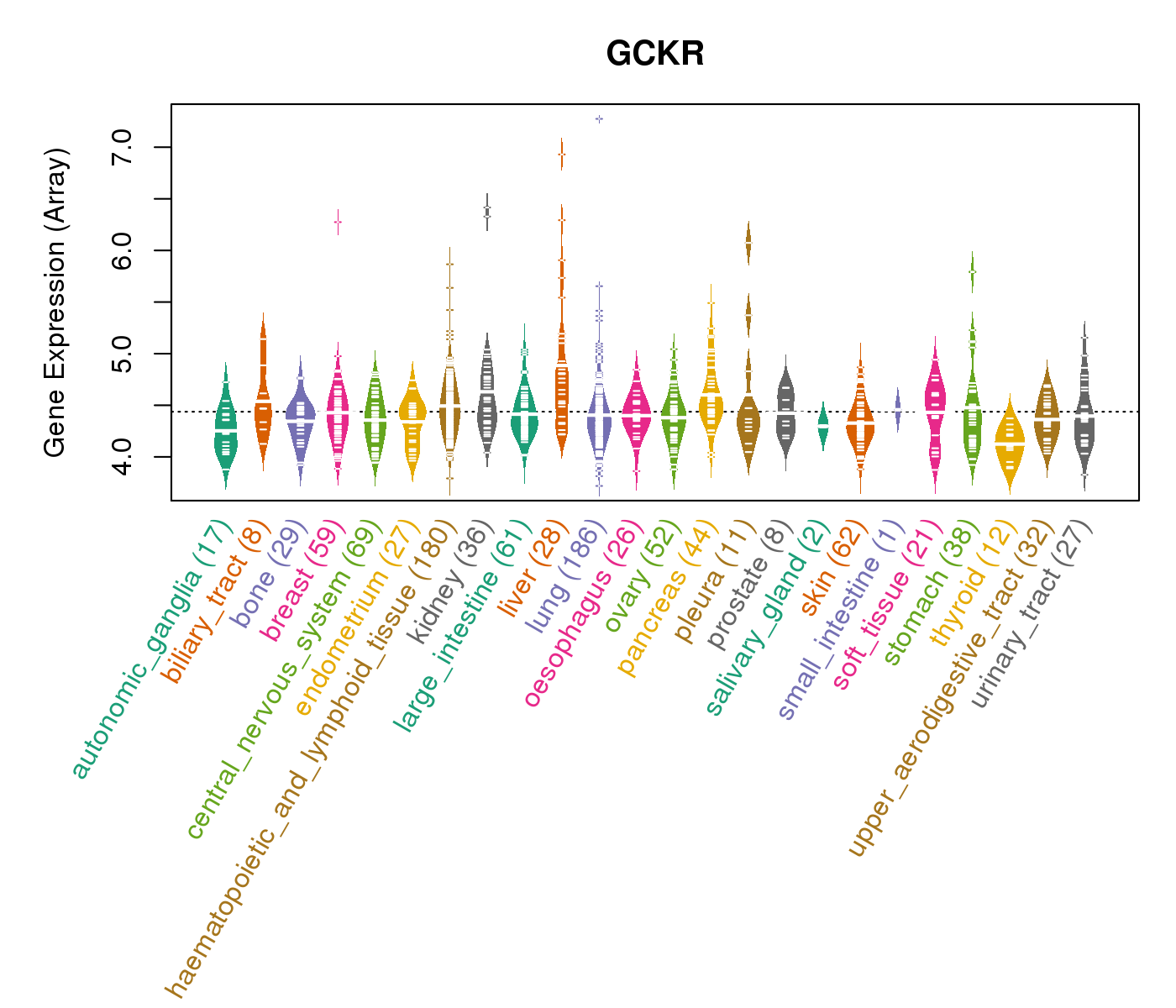 |
| * Normalized gene expression data of RNASeqV2 was extracted from TCGA using R package TCGA-Assembler. The URLs of all public data files on TCGA DCC data server were gathered at Jan-05-2015. Only eight cancer types have enough normal control samples for differential expression analysis. (t test, adjusted p<0.05 (using Benjamini-Hochberg FDR)) |
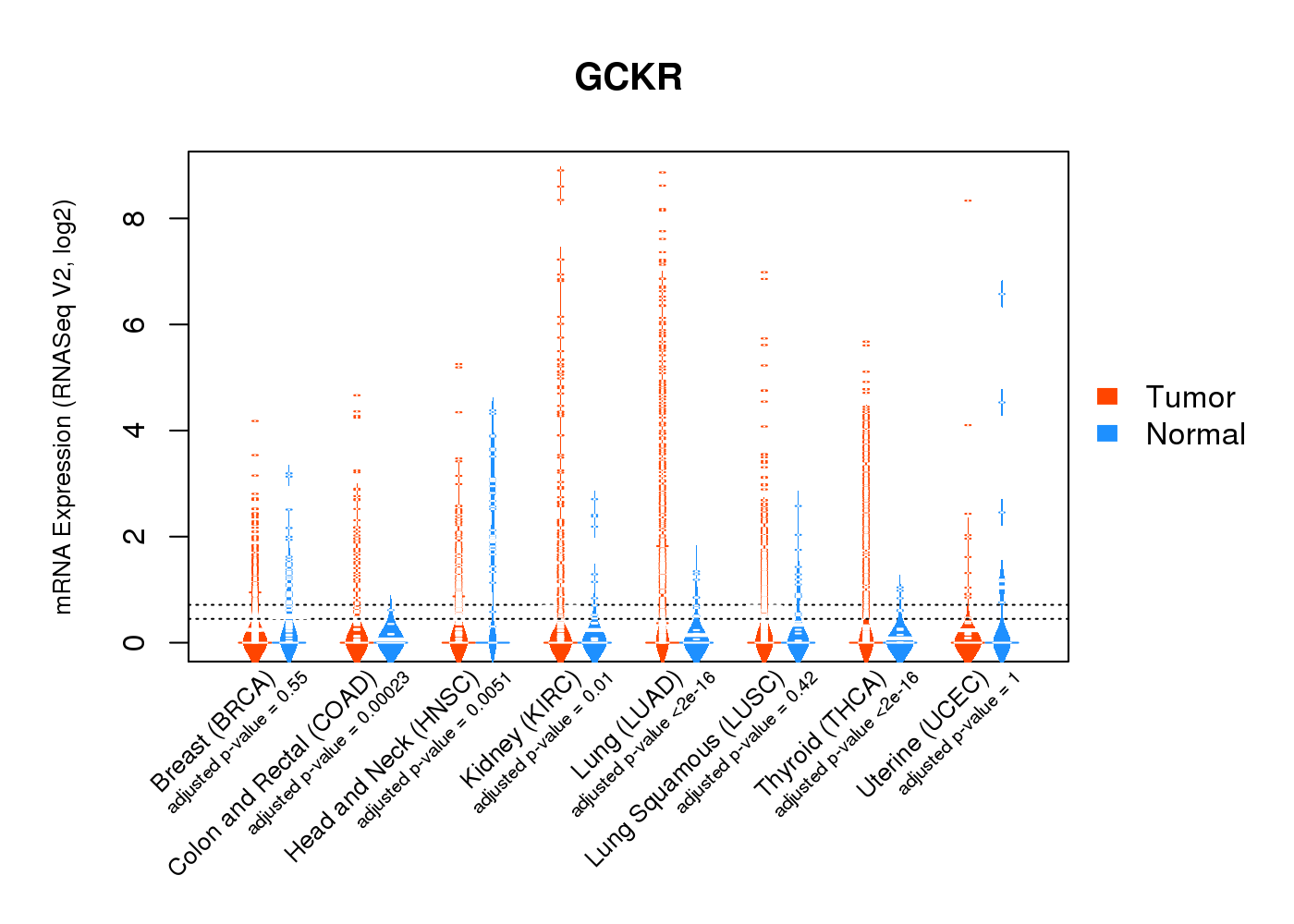 |
| Top |
| * This plots show the correlation between CNV and gene expression. |
: Open all plots for all cancer types
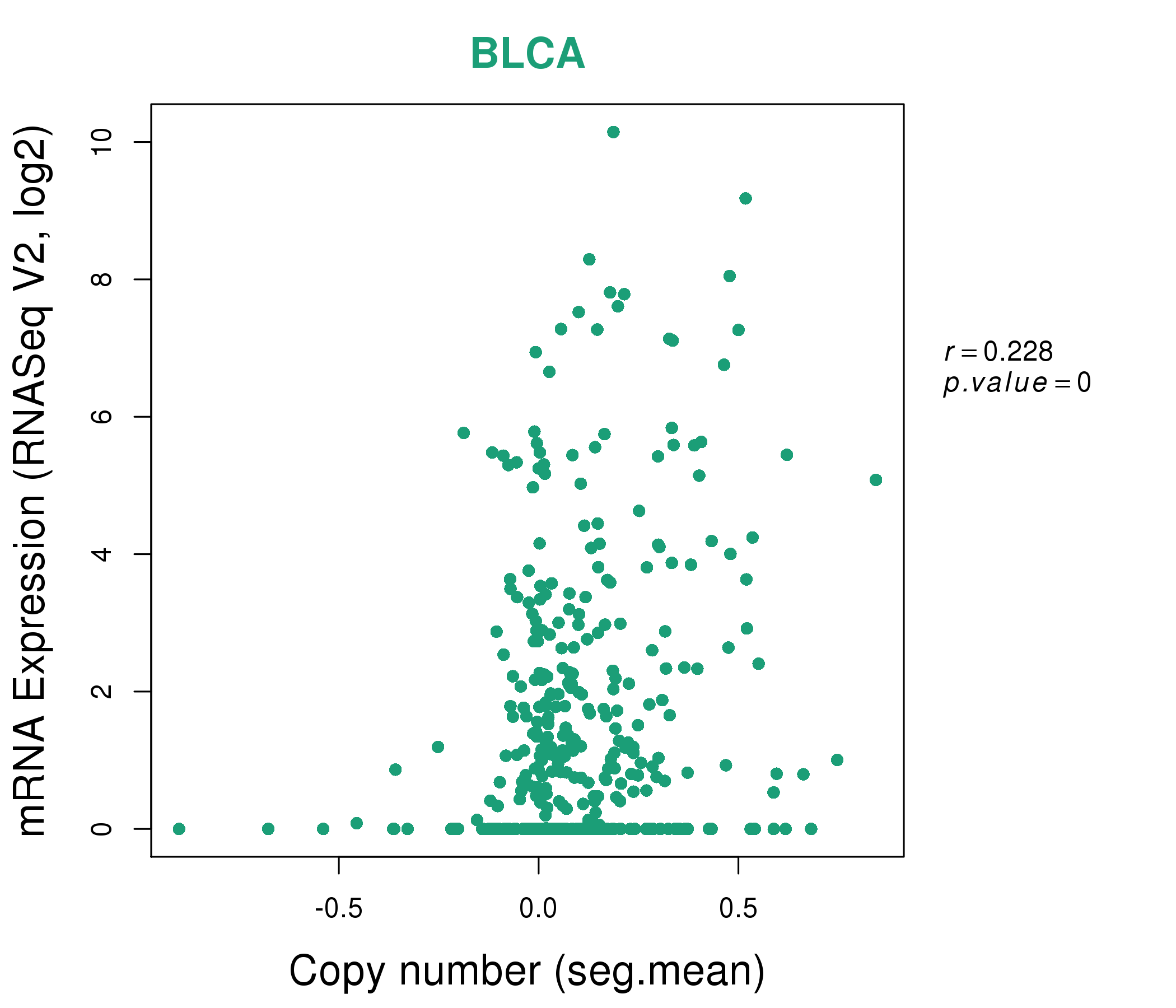 |
|
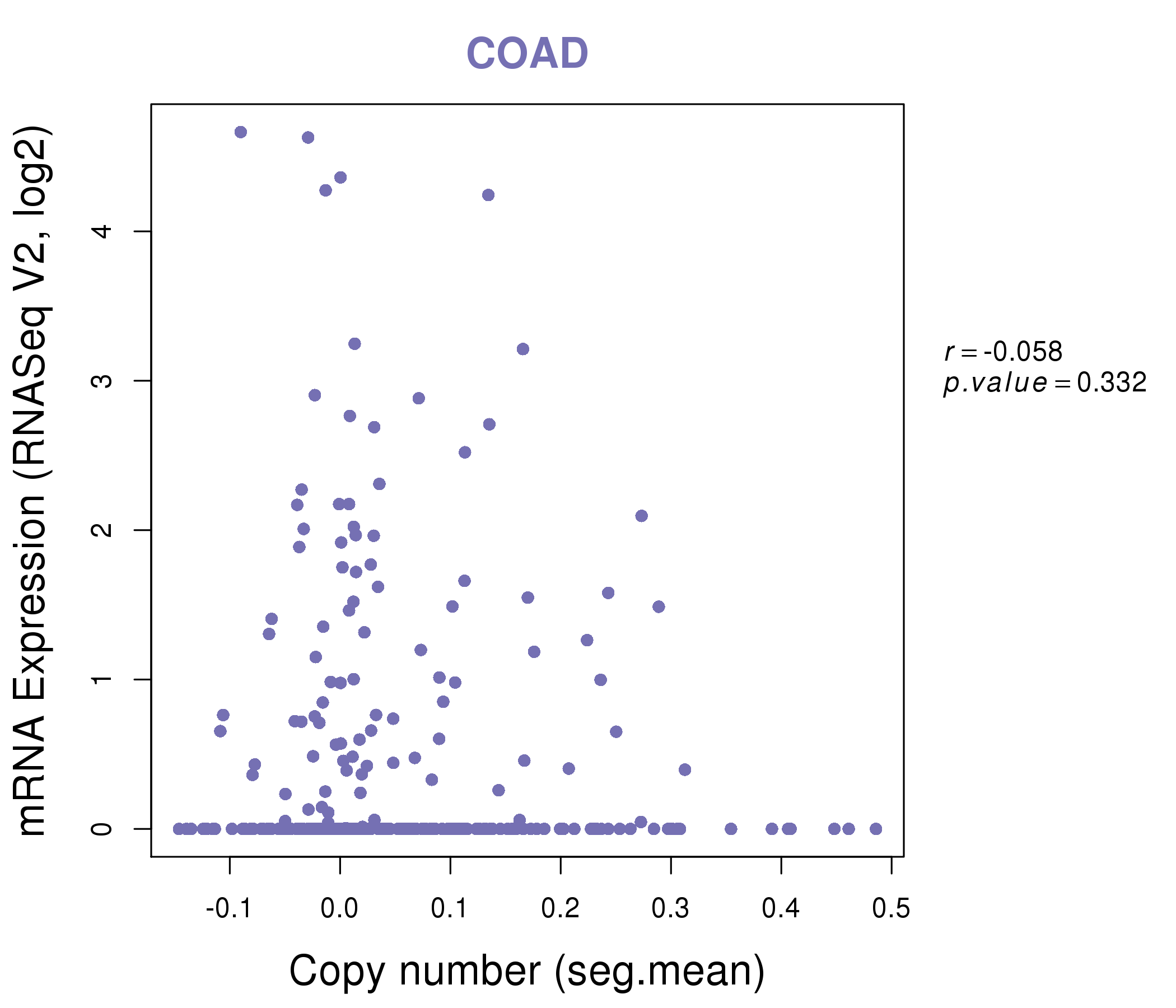 |
|
| Top |
| Gene-Gene Network Information |
| * Co-Expression network figures were drawn using R package igraph. Only the top 20 genes with the highest correlations were shown. Red circle: input gene, orange circle: cell metabolism gene, sky circle: other gene |
: Open all plots for all cancer types
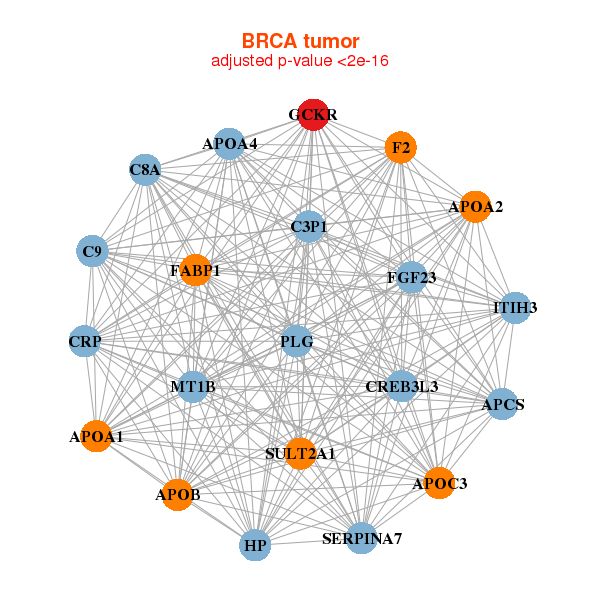 |
|
| APCS,APOA1,APOA2,APOA4,APOB,APOC3,C3P1, C8A,C9,CREB3L3,CRP,F2,FABP1,FGF23, GCKR,HP,ITIH3,MT1B,PLG,SERPINA7,SULT2A1 | BMP1,C14orf177,C6,C7,CETP,CTSL,FLVCR2, GCKR,GPR64,HMOX1,HTRA3,INSL4,KIR3DP1,MAPK11, OR2AG1,OR8D1,RHOXF2B,SCARNA20,SNORA19,SPATA8,TMEM114 |
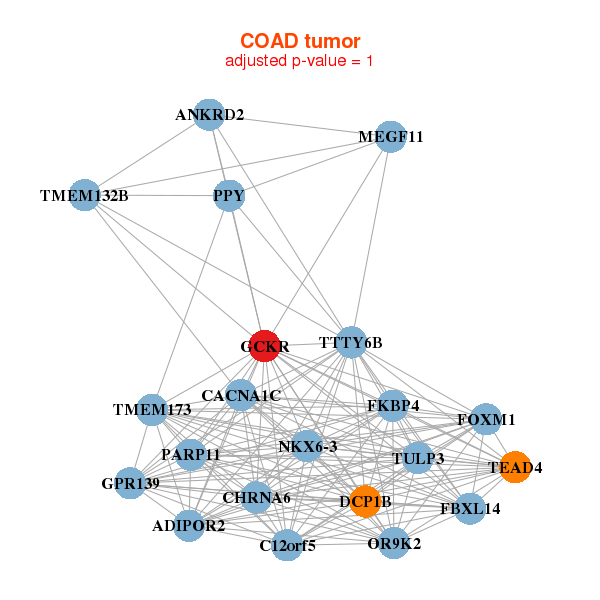 |
|
| ADIPOR2,ANKRD2,C12orf5,CACNA1C,CHRNA6,DCP1B,FBXL14, FKBP4,FOXM1,GCKR,GPR139,MEGF11,NKX6-3,OR9K2, PARP11,PPY,TEAD4,TMEM132B,TMEM173,TTTY6B,TULP3 | AFP,APC,CA3,DNAJB3,FAM66E,GCKR,GOLGA6L1, IQUB,CEP104,LOC100128573,LINC01312,MGC45800,NHLH1,OGDH, RIPPLY1,SENP2,SGMS2,SNRK,ST7-OT4,TMEM86B,UGT1A1 |
| * Co-Expression network figures were drawn using R package igraph. Only the top 20 genes with the highest correlations were shown. Red circle: input gene, orange circle: cell metabolism gene, sky circle: other gene |
: Open all plots for all cancer types
| Top |
: Open all interacting genes' information including KEGG pathway for all interacting genes from DAVID
| Top |
| Pharmacological Information for GCKR |
| There's no related Drug. |
| Top |
| Cross referenced IDs for GCKR |
| * We obtained these cross-references from Uniprot database. It covers 150 different DBs, 18 categories. http://www.uniprot.org/help/cross_references_section |
: Open all cross reference information
|
Copyright © 2016-Present - The Univsersity of Texas Health Science Center at Houston @ |






